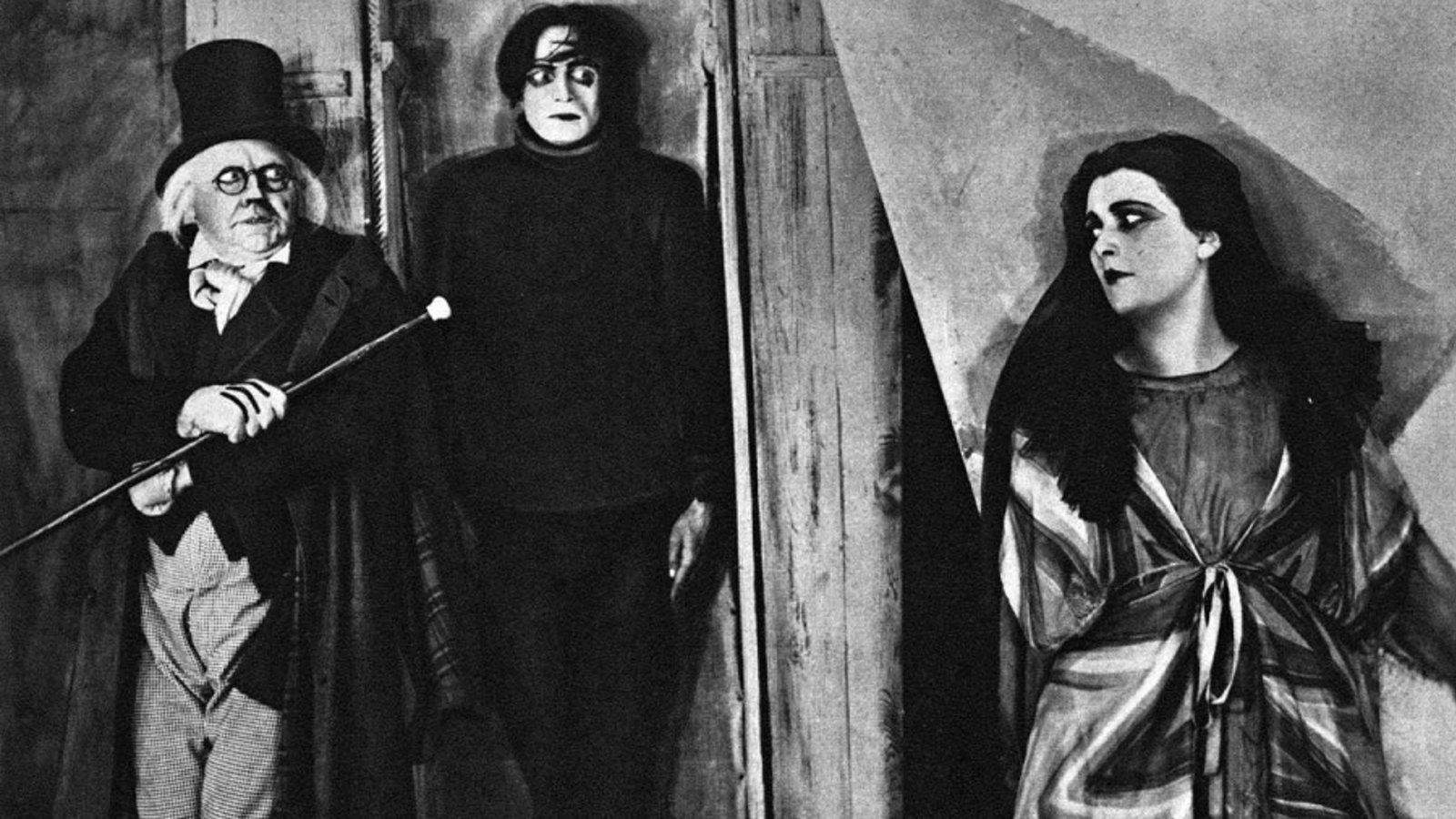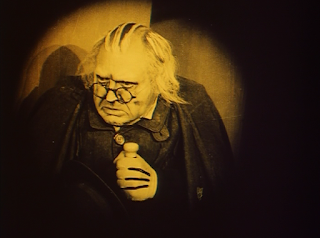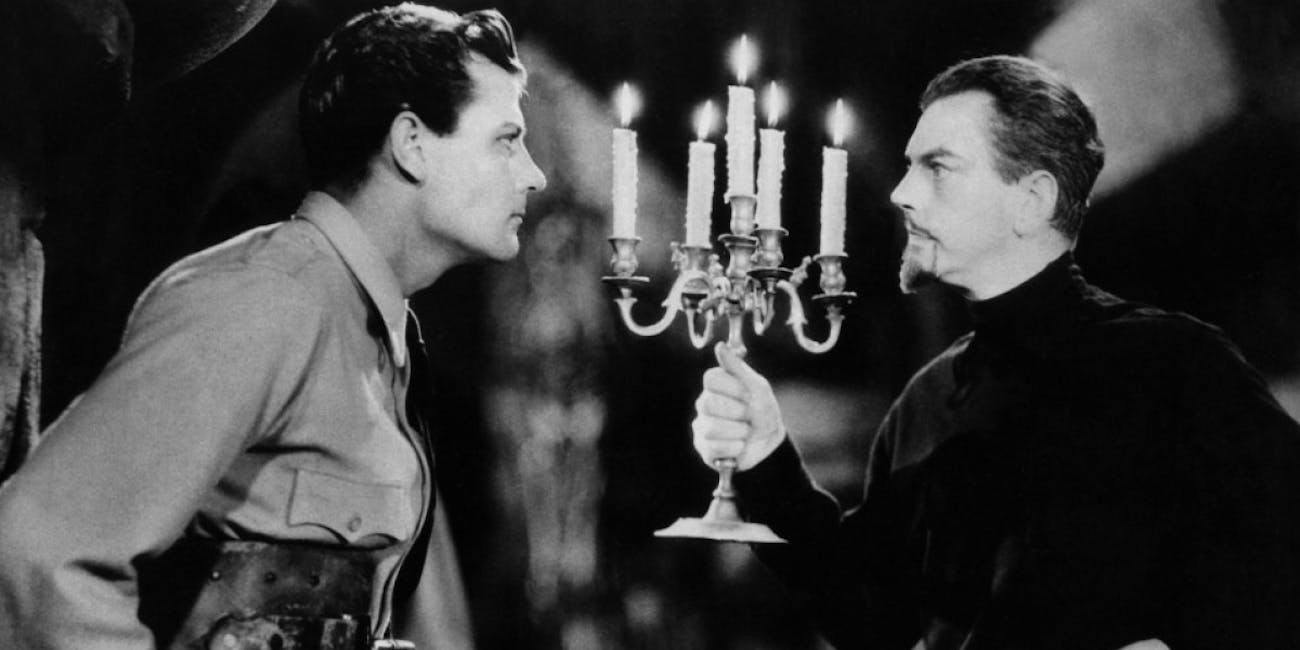What defines a psychological thriller? Well according to definitions.net,
a psychological thriller is a "thriller story which emphasizes the
psychology of its characters and their unstable emotional states. In terms of
classification, the category is a subgenre of the broader ranging thriller
category, with similarities to Gothic and detective fiction in the sense of
sometimes having a "dissolving sense of reality", moral ambiguity,
and complex and tortured relationships between obsessive and pathological characters.
Psychological thrillers often incorporate elements of mystery, drama, action,
and horror, particularly psychological horror." There are tons of great
examples that fit this description such as "Cape Fear", "Shutter
Island", "The Shining", "Silence of the Lambs", and
"Psycho". But I'm going to tackle the subject from the early stages
of cinema through different eras.
A perfect example of a psychological thriller film made in
the silent era of films is the famous German expressionism film "The Cabinet
of Dr. Caligari" that was groundbreaker for the art of film-making. The
film contains a surreal Gothic fantasy environment that would influence many
filmmakers (most notably Tim Burton) for how distorted everything appears.
Apart from the film’s first and last scene, the film contains an environment
that is distant from any kind of reality. Therefore, the film creates a world
of its own, that looks incredibly imaginative while also appearing ominous for
how these twisted pointy sets are consumed by darkness and shadows to establish
a horror environment.

To bring method to the madness to the film's bizarre look is
the story itself that is quite ahead of its time in regards to the use of
storytelling through cinema. The majority of the film takes place in the past
as opposed to the present, and even so, there would be a few flashbacks within
the flashback. Though it may not exactly be the first film to have a non-linear
story, its still one of the major influences especially regarding the last
scene of the movie. The film's story centers around two characters, the
film's protagonist Francis (Friedrich Feher) and antagonist Dr. Caligari
(Werner Krauss). Caligari is a traveling showman who features a somnambulist (a sleepwalker) named Cesare (Conrad Veidt), who has been asleep for 23 years inside a coffin
box. He awakes Cesare to answer questions from the audience concerning their
future. During Caligari’s visit, a series of murders have been taking place in
the town, causing Francis to suspect that Caligari has something to do with it.
It's easy to tell that Caligari is involved with the murders happening, only
throughout the course of the film, we're presented with so many twist and turns
that we’re given more questions that we’re eagerly waiting to see answered. The
film has all the ingredients that a psychological thriller should have through its
mysterious story line, dramatic surprises, and use of horror from the antagonist,
his slave, the atmosphere, and scenes of suspense.

However, a psychological thriller would never be
complete if the film didn't explore psychology of some of its characters, and
it most certainly delivers. During the course of the movie, we along with
Francis discover new information surrounding Caligari. At first, he's a
sinister looking showman. Then it's revealed he is the mastermind behind the
murders by ordering Cesare to do his dirty work for him, as he keeps a dummy of
him inside the box to avoid suspicion. Just when we think he's a crazy old who
escaped the town's insane asylum, it turns out he's the director of it. As we
wonder why the Doctor would commit such horrible deeds outside his profession, we
discover that he became obsessed with wanting to know the secrets of
controlling a somnambulist based on his research of a man from the 1700s with
the same name. Upon receiving a new patient who is somnambulist, he decides to
practice the experiments on him. But to fully achieve this he believes that he
must become Calgari himself, therefore forcing himself to believe that he is
the man resulting with him developing an alternate personality. His
unhealthy obsessions with discovering the secrets of the real Caligari have caused him to take up a violent alternate personality where he achieves his
goal of finding out Caligari's secrets. He successfully does but uses them to
kill people like the person he’s fascinated with instead of figuring out the
benefits that can be used with this kind of power, making it questionable if
his intentions of studying Caligari was beneficial in the first place.
The shocking part of this whole affair is nothing
surrounding the asylum director’s obsession matters in the slightest. In a bizarre twist, that no one would ever see coming (even from modern audiences who
have never seen the film), it’s revealed that everything we witnessed in
Francis’ past are nothing more than delusions that he has. Francis (if that's
his actual name) the whole time was a mental patient in an insane asylum who's
delusion are based on the people around him. The somnambulist Cesare
is actually a harmless inmate confused and lost as he fiddles with flowers. His
lover Jane is a patient who believes that she is a Queen. And the insane Asylum
director who believed he was Caligari, is the director of the asylum that
Francis is confined, who doesn't at look as intimidating as he did in Francis'
fantasies. Some may also notice how the film's portrayal of reality, looks less distorted than the scenes that take place in Francis' story, giving
audiences a very subtle hint that the events happening are not going on in the
film's world therefore explaining the film’s false sense of reality. During
this twist, we discover the cause of Francis' delusions, but not the reasons
why he was placed in the asylum. All we know is that he's insane as he hurts the
Doctor that wants to cure him, when in his fantasy he's the righteous hero
unmasking the demons of a mad doctor. The unique element of the movie that
makes it such a groundbreaking psychological horror film is not just for how
ahead of its time it is, not just for how visually amazing it is, but the fact
that the entire story takes place in the mind of a mentally unstable
individual. Ever since this film launched the popularity with its twist ending,
other filmmakers have been inspired to bring the same element of surprise when
dealing with the minds of people who are mentally disturbed.
Another example that may not be nearly as popular or groundbreaking
as "The Cabinet of Dr. Caligari" is "The Most Dangerous
Game", released in 1932 during the pre-code era. Like "The
Cabinet of Dr. Caligari”, the film contains all the elements that many would
expect to be part of the genre. As the characters
are forced to stay inside an old spooky dark castle, they question about the
nature of their host, what has happened to the people they were with, and what
he has hidden inside his trophy room resulting in a stunning twist. The mystery
of the story ends when it’s revealed, but the drama, horror remains when the
action portion of the story comes into to play as they fight for survival in the
jungle of the remote island they're stranded on.

The film suits the thriller part of the genre, while the
psychological elements is focused on the film's hero and villain. The
character who’s given a lot of depth out of the two is the film's antagonist
Count Zaroff (Leslie Banks). The one thing in life he obsesses over is hunting.
Ever since he was five years old, the thrill of tracking an animal down and
killing it has been more of a way of life to him than being just a fun sport. After
killing a large number of animals in many different exotic locations, hunting
has no longer been a thrill to him any more due to it being not as challenging
as it once was to him. By refusing to let his passion for the sport die, he
decides to hunt human beings, believing it will provide him more sport than what
a wild, furious beast can bring. He achieves this by living alone in a castle on
a deserted island, shifting buoys to lure ships to his Island and placing
dangerous obstacles to cause them to shipwreck. Any survivors that comes to his
door, he provides them with his hospitality by giving them food and shelter.
When he's ready to hunt his victims, he locks them up for an hour in a trophy
room filled with the heads of the men he's hunted to give them fear. As soon as
that hour is up he lets them loose in the jungle with a knife and a full day
start before the game begins. Although he still never loses, this new challenge
becomes his new obsession in life for how unique it is. He believes he's being
civilized by taking care of his victims, giving them a chance to survive, and
not shooting females when he's out hunting, but in reality he's just as savage
as the wild animals he's hunted.
Just like how "The Cabinet of Dr. Calgari"
supports the delusional state of mind that Francis' envisions through its
visually presentation, this film does the same. It's nowhere are as grand or
inspiring as the visuals from the previous film I analyzed. However,
when categorizing the look as being part of the psychological thriller it certainly fits the genre! The environments look intense, but it’s
how these environments connect with Zaroff's "disolving sense of
reality". The Castle's living room represents the tiny bit of civilized
behavior that Zaroff has. The trophy room reflects his madness. The empty ominous
castle is like Zaroff's mind of having nothing but dark intentions masquerading as something he considers civilized. And the jungle is his heaven since he can
play the sport that he loves without some kind of authority stopping him.

The film's protagonist Bob Rainsford is not a random civilian who found his way to Zaroff's island; he himself is a hunter, and a famous one too. He's the kind of person who believes an animal is savage for killing to survive, while hunting for sport is civilized, which he has completely backwards. But to him, since animals aren't exactly civilized like humans are, there's no need for him to think of their feelings. He goes as far to justify that he was acting in self-defense since his latest kill was hunting him first, rather than thinking that he was being hunted for invading the animal's territory with the intention to kill it. It's not until Zaroff puts him through the perspective of an animal when he becomes the hunted instead of the hunter. Like an animal, Bob only has his resources as he carries a knife (acting as his claw in this battle), who is forced to face every kind of terror that an animal has been through at his mercy. Through this experience Bob views Zaroff as a self-reflection to himself as a hunter, making him realize that he is the one who is savage as opposed to the animals he has hunted.
It doesn't matter how popular or obscure these old classic films are, they're both well made movies in their own right that perfectly fit the definition of the genre. Both contain a plot full of mystery, drama, horror, and action with the psyche of the protagonist and antagonist acting as the meat of the story. By watching these films we learn about how the obsessions of the antagonists takes an unhealthy effect on their life, as the protagonist are effected by the environments around them. And to reflect the characters state of mind whether it would be fear or insanity are the eerie environments surrounding them.
It doesn't matter how popular or obscure these old classic films are, they're both well made movies in their own right that perfectly fit the definition of the genre. Both contain a plot full of mystery, drama, horror, and action with the psyche of the protagonist and antagonist acting as the meat of the story. By watching these films we learn about how the obsessions of the antagonists takes an unhealthy effect on their life, as the protagonist are effected by the environments around them. And to reflect the characters state of mind whether it would be fear or insanity are the eerie environments surrounding them.
No comments:
Post a Comment